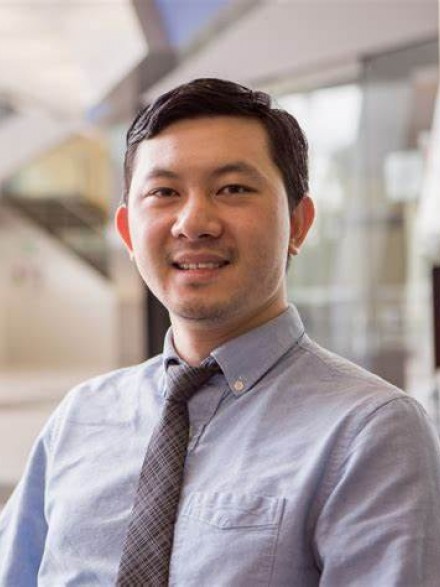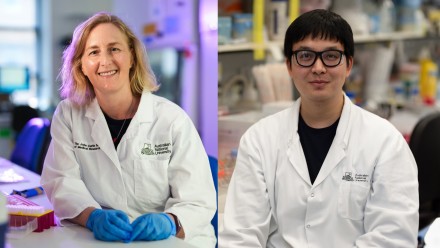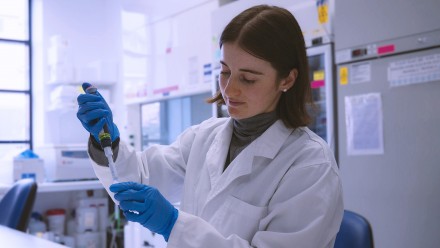Professor Si Ming Man

Contacts
Training:
- UNSW Australia, Sydney, Australia
- University of Cambridge, UK
- St Jude Children’s Research Hospital, Memphis, Tennessee, USA
Honours and Awards:
- Fellow, The Royal Society of NSW (2023)
- Australian Academy of Science Gottschalk Medal (2023)
- UNSW Alumni Award for Research & Teaching Achievements (2023)
- Frank Fenner Prize for Life Scientist of the Year, Prime Minister's Prizes for Science (2022)
- CSL Centenary Fellowship (2021)
- Australian Society for Medical Research Peter Doherty Leading Light Award (2020)
- Australian Society for Biochemistry & Molecular Biology Eppendorf Edman Early Career Award (2020)
- The Australian National University Vice-Chancellor's Award for Early Career Academic Excellence (2020)
- Commonwealth Health Minister's Medal for Excellence in Health and Medical Research (2019)
- The Royal Society of NSW Edgeworth David Medal (2019)
- NHMRC Research Excellence Award for the highest-ranked Career Development Fellowship Biomedical Level 1 (2019)
- American Association of Immunologists Pfizer-Showell Award (2019)
- Fellow, The Australian Society for Microbiology (2019)
- Australian Society for Microbiology Jim Pittard Early Career Award (2017)
- American Association of Immunologists Thermo Fisher Trainee Achievement Award (2016)
- International Cytokine & Interferon Society Milstein Young Investigator Award (2016)
- NHMRC Research Excellence Award for the highest-ranked Early Career Fellowship (2015)
- NHMRC/R.G. Menzies Early Career Fellowship 2015–2018
- Neoma Boadway Endowed Fellowship – St Jude Children’s Research Hospital, 2014
- Cambridge International Scholarship, University of Cambridge, U.K. 2009–2013
- UNSW Faculty of Science Award for Excellence in Sessional Teaching – UNSW, 2009
Research interests
Our lab investigates the role of innate immunity in infectious diseases and cancer. Pattern-recognition receptors are germ-line encoded innate immune sensors which detect pathogen-associated molecular patterns (PAMPs) and danger-associated molecular patterns (DAMPs). These receptors activate signalling pathways and mediate the production of inflammatory cytokines, type I interferons and other anti-microbial molecules. We use cutting-edge technology to study the mechanisms by which host sensors recognise bacteria, viruses and parasites, and how these sensors shape the overall immune response to infection. We also study the molecular basis by which uncontrolled inflammation can lead to the development of cancer, autoimmunity and inflammatory diseases.
Student Projects
- Uncovering how host cells recognise and respond to intracellular pathogens and danger signals.
- Unravelling the molecular mechanisms of inflammasome formation.
- Understanding the role of innate immune sensors in regulating the development of cancer and the composition of the gut microbiota.
- Identifying novel activators and inhibitors of the innate immune system to prevent and treat infection, autoinflammatory diseases and cancer.
Groups
- Enosi Tuipulotu, D, Feng, S, Pandey, A et al. 2023, 'Immunity against Moraxella catarrhalis requires guanylate-binding proteins and caspase-11-NLRP3 inflammasomes', The EMBO Journal, vol. 42, no. 6, pp. e112558.
- Kirkby, M, Enosi Tuipulotu, D, Feng, S et al. 2023, 'Guanylate-binding proteins: mechanisms of pattern recognition and antimicrobial functions', Trends in Biochemical Sciences, vol. 48, no. 10, pp. 883-893.
- Pandey, A, Kurera, M & Man, S 2023, 'Primary Intestinal Fibroblasts: Isolation, Cultivation, and Maintenance', in Brendan J. Jenkins (ed.), Inflammation and Cancer, Humana, New York, NY, USA, pp. 327-335.
- Turnbull, C, Bones, J, Stanley, M et al. 2023, 'DECTIN-1: A modifier protein in CTLA-4 haploinsufficiency', Science Advances, vol. 9, no. 49.
- Man, S & Jenkins, B 2022, 'Context-dependent functions of pattern recognition receptors in cancer', Nature Reviews Cancer, vol. 22, pp. 397ââ¬â413.
- Zhao, A, Kirkby, M & Man, S 2022, 'Streptococcus makes the cut: Gasdermin A-induced pyroptosis', Cell Host and Microbe, vol. 30, no. 4, pp. 410ââ¬â412.
- Feng, S, Enosi Tuipulotu, D, Pandey, A et al. 2022, 'Pathogen-selective killing by guanylate-binding proteins as a molecular mechanism leading to inflammasome signaling', Nature Communications, vol. 13, no. 4395.
- Jing, W, Lo Pilato, J, Kay, C et al. 2022, 'Clostridium septicum α-toxin activates the NLRP3 inflammasome by engaging GPI-anchored proteins', Science Immunology, vol. 7, no. 71, pp. eabm1803.
- Simpson, D, Pang, J, Weir, A et al. 2022, 'Interferon-γ primes macrophages for pathogen ligand-induced killing via a caspase-8 and mitochondrial cell death pathway
', Immunity, vol. 55, no. 3, pp. 423-441.e9. - Ebrahimnezhaddarzi, S, Bird, C, Allison, C et al. 2022, 'Mpeg1 is not essential for antibacterial or antiviral immunity, but is implicated in antigen presentation', Immunology and Cell Biology, vol. 100, no. 7, pp. 529-546.
- Pandey, A, Shen, C, Feng, S et al. 2021, 'Cell biology of inflammasome activation', Trends in Cell Biology, vol. 31, no. 11, pp. 924-939.
- Deshpande, N, Riordan, S, Gorman, C et al. 2021, 'Multi-omics of the esophageal microenvironment identifies signatures associated with progression of Barrett’s esophagus', Genome Medicine, vol. 13, pp. 1-21.
- Tseng, Y, Croft, S, Smith, S et al. 2021, 'Viperin has species-specific roles in response to herpes simplex virus infection', Journal of General Virology, vol. 102, no. 8.
- Wooff, Y, Man, S, Aggio-Bruce, R et al. 2019, 'IL-1 Family Members Mediate Cell Death, Inflammation and Angiogenesis in Retinal Degenerative Diseases', Frontiers in Immunology, vol. 10.
- Man, S & Kanneganti, T 2016, 'Type I Interferon Keeps IL-1b in Check', Cell Host and Microbe, vol. 19, no. 3, pp. 272 - 274.
- Man, S & Kanneganti, T 2016, 'Regulation of lysosomal dynamics and autophagy by CSTB/cathepsin B', Autophagy, vol. 12, no. 12, pp. 2504 - 2505.
- Jing, W, Lo Pilato, J, Kay, C et al. 2021, 'Activation mechanisms of inflammasomes by bacterial toxins', Cellular Microbiology, vol. 23, no. 4, pp. e13309.
- Wooff, Y, Fernando, N, Wong, H et al. 2020, 'Caspase-1-dependent inflammasomes mediate photoreceptor cell death in photo-oxidative damage-induced retinal degeneration', Scientific Reports, vol. 10.
- Fernando, N, Wong, H, Das, S et al. 2020, 'MicroRNA-223 Regulates Retinal Function and Inflammation in the Healthy and Degenerating Retina', Frontiers in Cell and Developmental Biology, vol. 8, pp. 1-18.
- Mathur A, Feng S, Hayward JA, Ngo C, Fox D, Atmosukarto II, Price JD, Schauer K, Märtlbauer E, Robertson AAB, Burgio G, Fox EM, Leppla SH, Kaakoush NO, Man SM. 2019, A multicomponent toxin from Bacillus cereus incites inflammation and shapes host outcome via the NLRP3 inflammasome. Nature Microbiology. https://www.ncbi.nlm.nih.gov/pubmed/30531979
- Man, S 2018, 'Inflammasomes in the gastrointestinal tract: roles in infection, cancer and gut microbiota homeostasis', Nature Reviews Gastroenterology & Hepatology.15, 721–737.
- Fox, D, Mathur, A, Xue, Y et al. 2020, 'Bacillus cereus non-haemolytic enterotoxin activates the NLRP3 inflammasome', Nature Communications, vol. 11, no. 760, pp. 1-16.
- Feng, S & Man, S 2020, 'Captain GBP1: inflammasomes assemble, pyroptotic endgame', Nature Immunology, vol. 21, no. 8, pp. 829ïÿý830.
- Man, S & Kanneganti, T 2016, 'Converging roles of caspases in inflammasome activation, cell death and innate immunity', Nature Reviews Immunology, vol. 16, no. 1, pp. 7-21.
- Enosi Tuipulotu, D, Mathur, A, Ngo, C et al. 2020, 'Bacillus cereus: Epidemiology, Virulence Factors, and Host-Pathogen Interactions [IN PRESS]', Trends in Microbiology, vol. online.
- Kay, C, Wang, R, Kirkby, M et al. 2020, 'Molecular mechanisms activating the NAIP‐NLRC4 inflammasome: Implications in infectious disease, autoinflammation, and cancer', Immunological Reviews, vol. 297, pp. 67-82.
- Man, S, Karki, R, Sasai, M et al 2016, 'IRGB10 liberates bacterial ligands for sensing by the AIM2 and caspase-11-NLRP3 inflammasomes', Cell, vol. 167, no. 2, pp. 382-396.
- Man, S, Zhu, Q, Zhu, L et al 2015, 'Critical role for the DNA sensor AIM2 in stem cell proliferation and cancer', Cell, vol. 162, no. 1, pp. 45-58.
- Karki, R, Man, S, Malireddi, R et al. 2016, 'NLRC3 is an inhibitory sensor of PI3K-mTOR pathways in cancer', Nature, vol. 540, no. 7634, pp. 583-589.
- Man, S, Karki, R, Malireddi, R et al 2015, 'The transcription factor IRF1 and guanylate-binding proteins target activation of the AIM2 inflammasome by Francisella infection', Nature Immunology, vol. 16, no. 5, pp. 467-U174.
- Man, S, Hopkins, L, Nugent, E et al 2014, 'Inflammasome activation causes dual recruitment of NLRC4 and NLRP3 to the same macromolecular complex', PNAS - Proceedings of the National Academy of Sciences of the United States of America, vol. 111, no. 20, pp. 7403-7408.
- Man, S, Ekpenyong, A, Tourlomousis, P et al 2014, 'Actin polymerization as a key innate immune effector mechanism to control Salmonella infection', PNAS - Proceedings of the National Academy of Sciences of the United States of America, vol. 111, no. 49, pp. 17588-17593.
- Zaki, M, Man, S, Vogel, P et al 2014, 'Salmonella exploits NLRP12-dependent innate immune signaling to suppress host defenses during infection', PNAS - Proceedings of the National Academy of Sciences of the United States of America, vol. 111, no. 1, pp. 385-390.
- Man, S 2011, 'The clinical importance of emerging Campylobacter species', Nature Reviews. Gastroenterology & Hepatology, vol. 8, no. 12, pp. 669-685.
- Man, S, Kaakoush, N & Mitchell, H 2011, 'The role of bacteria and pattern-recognition receptors in Crohn's disease', Nature Reviews. Gastroenterology & Hepatology, vol. 8, no. 3, pp. 152-168.
- Kuriakose, T, Man, S, Malireddi, R et al 2016, 'ZBP1/DAI is an innate sensor of influenza virus triggering the NLRP3 inflammasome and programmed cell death pathways', Science Immunology, vol. 1, no. 2.
- Qi, X, Man, S, Malireddi, R et al 2016, 'Cathepsin B modulates lysosomal biogenesis and host defense against Francisella novicida infection', Journal of Experimental Medicine, vol. 213, no. 10, pp. 2081-2097.
- Xue, Y, Enosi Tuipulotu, D, Tan, W, Kay, C, Man, S. 2019, 'Emerging activators and regulators of inflammasomes and pyroptosis', Trends in Immunology, vol. 40, no. 11, pp. 1035-1052.
- Vince, J, De Nardo, D, Gao, W et al 2018, 'The Mitochondrial Apoptotic Effectors BAX/BAK Activate Caspase-3 and -7 to Trigger NLRP3 Inflammasome and Caspase-8 Driven IL-1β Activation', Cell Reports, vol. 25, no. 9, pp. 2339-2353pp.
- Kaakoush, N, Castano-Rodriguez, N, Man, S et al 2015, 'Is Campylobacter to esophageal adenocarcinoma as Helicobacter is to gastric adenocarcinoma?', Trends in Microbiology, vol. 23, no. 8, pp. 455-462.
- Xue, Y & Man, S 2018, 'ALPK1: Innate attraction to the sweetness of bacteria', Cell Research, vol. 28, pp. 1125-1126.
- Zhu, Q, Man, S, Karki, R et al 2018, 'Detrimental Type I Interferon Signaling Dominates Protective AIM2 Inflammasome Responses during Francisella novicida Infection', Cell Reports, vol. 22, no. 12, pp. 3168-3174pp.
- Mathur, A, Hayward, J & Man, S 2018, 'Molecular mechanisms of inflammasome signaling', Journal of Leukocyte Biology, vol. 103, no. 2, pp. 233-257.
- Feng, S, Fox, D & Man, S 2018, 'Mechanisms of Gasdermin Family Members in Inflammasome Signaling and Cell Death', Journal of Molecular Biology, vol. 430, no. 18, pp. 3068-3080pp.
- Man, S, Karki, R, Briard, B et al 2017, 'Differential roles of caspase-1 and caspase-11 in infection and inflammation', Scientific Reports, vol. 7, no. 45126, pp. 1-11pp.
- Man, S, Karki, R & Kanneganti, T 2017, 'Molecular mechanisms and functions of pyroptosis, inflammatory caspases and inflammasomes in infectious diseases', Immunological Reviews, vol. 277, no. 1, pp. 61-75.
- Ngo, C & Man, S 2017, 'NLRP9b: a novel RNA-sensing inflammasome complex', Cell Research, vol. 27, pp. 1302-1303.
- Man, S, Place, D, Kuriakose, T et al 2017, 'Interferon-inducible guanylate-binding proteins at the interface of cell-autonomous immunity and inflammasome activation', Journal of Leukocyte Biology, vol. 101, no. 1, pp. 143-150.
- Liu, Z, Man, S, Zhu, Q et al 2016, 'DOCK2 confers immunity and intestinal colonization resistance to Citrobacter rodentium infection', Scientific Reports, vol. 6, no. 27814, pp. 1-9.
- Man, S, Karki, R & Kanneganti, T 2016, 'DNA-sensing inflammasomes: regulation of bacterial host defense and the gut microbiota', Pathogens and Disease, vol. 74, no. 4, pp. 1-9.
- Shen, C, Pandey, A & Man, S 2020, 'Gasdermins deliver a deadly punch to cancer', Cell Research, vol. 30, pp. 463â464.
- Karki, R, Man, S & Kanneganti, T 2017, 'Inflammasomes and cancer', Cancer Immunology Research, vol. 5, no. 2, pp. 94-99.
- Hayward JA, Mathur A, Ngo C, Man S. 2018, 'Cytosolic Recognition of Microbes and Pathogens: Inflammasomes in Action', Microbiology and Molecular Biology Reviews, vol. 82, no. 4, pp. 1-40pp.
- Karki, R, Man, S, Malireddi, R et al 2015, 'Concerted activation of the AIM2 and NLRP3 inflammasomes orchestrates host protection against Aspergillus infection', Cell Host and Microbe, vol. 17, no. 3, pp. 357-368.
- Pandey, A, Shen, C & Man, S 2019, 'Inflammasomes in Colitis and Colorectal Cancer: Mechanism of Action and Therapies', Yale Journal of Biology and Medicine, vol. 92, no. 3, pp. 481-498.
- Man, S, Karki, R & Kanneganti, T 2016, 'AIM2 inflammasome in infection, cancer, and autoimmunity: Role in DNA sensing, inflammation, and innate immunity', European Journal of Immunology, vol. 46, no. 2, pp. 269-280.
- Kaakoush, N, Castano-Rodriguez, N, Mitchell, H, Man, S. 2015, 'Global epidemiology of Campylobacter infection', Clinical Microbiology Reviews, vol. 28, no. 3, pp. 687-720.
- Kaakoush, N, Deshpande, N, Man, S et al 2015, 'Transcriptomic and proteomic analyses reveal key innate immune signatures in the host response to the gastrointestinal pathogen Campylobacter concisus', Infection and Immunity, vol. 83, no. 2, pp. 832-845.
- Kaakoush, N, Mitchell, H & Man, S 2015, 'Campylobacter', in Tang, Y.W (ed.), Molecular Medical Microbiology, Academic Press - Elsevier, London, pp. 1187-1236pp.
- Man, S & Kanneganti, T 2015, 'Regulation of inflammasome activation', Immunological Reviews, vol. 265, no. 1, pp. 6-21.
- Ngo, C & Man, S 2017, 'Mechanisms and functions of guanylate‐binding proteins and related interferon‐inducible GTPases: Roles in intracellular lysis of pathogens', Cellular Microbiology, vol. 19, no. 12, pp. e12791.
- Kaakoush, N, Mitchell, H & Man, S 2014, 'Role of Emerging Campylobacter Species in Inflammatory Bowel Diseases', Inflammatory Bowel Diseases, vol. 20, no. 11, pp. 2189-2197.
- Zhu, Q, Man, S, Gurung, P et al 2014, 'CUTTING EDGE: STING mediates protection against colorectal tumorigenesis by governing the magnitude of intestinal inflammation', Journal of Immunology, vol. 193, no. 10, pp. 4779-4782.
- Ekpenyong, A, Man, S, Achouri, S et al 2013, 'Bacterial infection of macrophages induces decrease in refractive index', Journal of Biophotonics, vol. 6, no. 5, pp. 393-397.
- Man, S, Tourlomousis, P, Hopkins, L et al 2013, 'Salmonella infection induces recruitment of Caspase-8 to the inflammasome to modulate IL-1β production', Journal of Immunology, vol. 191, no. 10, pp. 5239-5246.
- Kaakoush, N, Man, S, Lamb, S et al. 2010, 'The secretome of Campylobacter concisus', The FEBS Journal, vol. 277, no. 7, pp. 1606-1617.
- Man, S, Zhang, L, Day, A et al 2010, 'Campylobacter concisus and other Campylobacter species in children with newly diagnosed Crohn's Disease', Inflammatory Bowel Diseases, vol. 16, no. 6, pp. 1008-1016.
- Kaakoush, N, Holmes, J, Octavia, S et al. 2010, 'Detection of Helicobacteraceae in intestinal biopsies of children with Crohn's disease', Helicobacter (Oxford), vol. 15, no. 6, pp. 549-557.
- Man, S, Kaakoush, N, Octavia, S et al 2010, 'The Internal Transcribed Spacer region, a new tool for use in species differentiation and delineation of systematic relationships within the Campylobacter genus', Applied and Environmental Microbiology, vol. 76, no. 10, pp. 3071-3081.
- Man, S, Kaakoush, N, Leach, S et al 2010, 'Host attachment, invasion, and stimulation of proinflammatory cytokines by Campylobacter concisus and other non-Campylobacter jejuni Campylobacter species', The Journal of Infectious Diseases, vol. 202, no. 12, pp. 1855-1865.
- Zhang, L, Man, S, Day, A et al 2009, 'Detection and isolation of Campylobacter species other than C. jejuni from children with Crohn's disease.', Journal of Clinical Microbiology, vol. 47, no. 2, pp. 453-455.
- Man, S, Zhang, L, Day, A et al 2008, 'Detection of enterohepatic and gastric helicobacter species in fecal specimens of children with Crohn's disease', Helicobacter (Oxford), vol. 13, no. 4, pp. 234-238.







